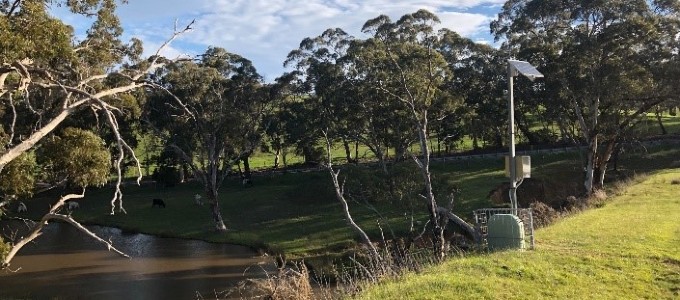Flows for the Future

Client: Department for Environment and Water, Government of South Australia
Location: Mount Lofty Ranges, South Australia
Date: 2017 - ongoing
Supporting environmental and agricultural sustainability by managing low-flows
Background
The Eastern Mount Lofty Ranges in South Australia are the traditional lands of the Ngadjuri, Kaurna, Peramangk and Ngarrindjeri people. The ranges contain more than 8,000 dams which provide the essential water storage needed to support agriculture in the region. However, the combination of water storage and water extraction has negatively affected the timing and volume of the natural water flows that are critical for healthy waterways and for the vegetation and aquatic creatures that rely on them. The effects of interruption to the natural water flows are most pronounced in times of low flow – which may become more frequent if the climate becomes hotter and drier due to climate change.
The Flows for the Future Program is a joint Australian and South Australian government-funded initiative supporting the delivery of the Murray-Darling Basin Plan objectives across the Eastern Mount Lofty Ranges. It aims to achieve greater sustainability by balancing the needs of water users with the health of the catchments in the Eastern Mount Lofty Ranges. This will be done by diverting low-flows past the dams, allowing this water back into the natural waterways for a more natural flow pattern and a healthier environment.
Solution
Entura was engaged to design, install and commission a low-flow dam-release system that could automatically return water from agricultural diversions to the natural water catchment to support strong and sustainable agriculture and tourism industries in the area.
Each site had unique site-specific environmental and technical challenges, different flow regimes, and a range of landowner needs. Site design challenges included collecting real-time data from weirs located large distances apart across challenging topography. Remote input and output control via radio link was needed to allow for automatic valve operation and to ensure accurate flow data could be identified by the low-flow release device.
Entura applied our hydrology, environmental and engineering expertise to design six different bespoke models of low-flow release devices to suit the range of sites. Detailed design and Factory Acceptance Testing (FAT) was carried out in Entura’s Adelaide testing facilities, allowing us to further improve the design before deployment.
We took a modular approach to design due to the varying requirements of individual sites and possible configurations of sequential and parallel dam systems. We could then include and modify basic flow-release features selectively, tailored to each specific location. This minimised hardware costs and provided a consistent and simple solution that could be used across the network.
To maintain a healthy water system, the devices have been designed to sense and record flow duration and volume, and to use this information to calculate a low-flow release amount. The low flows can then be diverted around dams and into the waterways below.
In periods of higher flows when there is sufficient water entering the catchment, water is able to enter and fill the dams.
The devices have a low visual and environmental impact due to the natural and remote regional locations of installations. Energy efficiency was considered as a fundamental and critical part of the design. The Program chose to power the devices through solar and battery power alone so that mains power is not required, minimising wiring and disruption to the local environment.
Services provided
- Control system design
- Commissioning
- Water metering
- Remote telemetry
Outcome
Working collaboratively and in partnership with a range of water industry experts, landholders and government, Entura has played a significant role in enabling this important program to achieve its goals. The installed devices have returned low flows for more than 400 sites, allowing more water to flow into creeks in low-flow periods for ecological needs, such as to support vegetation, fish, insects and other water-reliant species.
The Program is delivered under the Murray-Darling Basin Plan by the Flows for the Future Program, and jointly funded through the Australian Government Department of Agriculture, Water and the Environment and the South Australian Department for Environment and Water.


